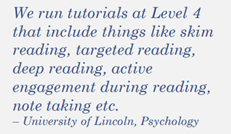In this blog post, Annabelle Mansell, one of our student researchers (and a third-year Classical Studies student at the University of Lincoln), shares what she learnt from analysing survey responses that addressed questions of accessibility. As we saw in the last blog post, students – and, to a lesser extent, staff – see accessibility as one of the main benefits of reading online. But it can also have drawbacks in this respect, for some students at least, as Annabelle’s post makes clear.
While every individual respondent has their own personal experience to report, some trends became apparent when I looked across the responses to questions about practices (for students) and pedagogies (for staff) in relation to reading for academic purposes, including the broad issue of how to make academic reading accessible for everyone regardless of level. Both staff and student responses considered the academic, emotional, and technical accessibility of reading for university-level study.

First, responses from staff to the question ‘how do you encourage students to engage in reading (online and offline) in your discipline?’ often discussed accessibility. The majority of responses focused on the mandatory nature of reading within their discipline and the methods that they used to to encourage students to engage with the ‘essential’ reading. Responses showed that staff wished to encourage students by setting them a manageable task, giving them the necessary tools to complete the task, and motivating them to do the reading, all three avenues aimed at making academic reading as accessible for students as possible.
The majority of staff recognised that setting students a manageable yet appropriately challenging reading task (and which is technically accessible, usually via online platforms) could be a powerful driver for engagement. Many staff wrote that they were careful in selecting appropriate mandatory readings for their students, ensuring that they were relevant, of an appropriate length and difficulty. Some staff also stressed that providing guidance for set texts in the form of questions or introductions helped to make the set reading more accessible for students. Therefore, it was a notable trend in the responses that staff make a considered effort to ensure that mandatory readings are academically accessible for students. This was designed to encourage students by neither over- or underestimating their abilities nor by causing them unnecessary stress by setting inappropriate tasks.

Second, many staff expressed that equipping students with the correct tools to approach texts was a key method for encourages them to read. For example, teaching reading methods and developing skills through dedicated workshops or through in-class activities, including group reading exercises, encourages students to practice approaching texts and helps them to feel more confident and more comfortable with academic reading. By equipping students with the necessary skills, academic reading becomes more accessible, both emotionally and academically.
Finally, when students have a manageable task and the skills necessary to complete it, a few responses considered how to provide the final push to motivate students to read. Some respondents wrote about how they encouraged students by emphasising, either verbally or in writing, the value and necessity of reading to achieve success within their discipline. While it is easy to assume that reading is an inherent, implicit element of some disciplines, respondents acknowledged the value in communicating this clearly to students.
It therefore appears that academics are aware of the multiple factors that affect how students approach reading, and the majority of staff are considerate of how to encourage students to read and how to craft an appropriate environment for reading within their disciplines.
This concern with accessibility was also apparent in students’ responses to the question asking them how they read on a weekly basis. While there were many different answers to this question when students read, for how long, where, and how they digest material, accessibility was a key overarching theme.
Within first-year undergraduate responses, there were over 60 references to online reading (as opposed to the 29 responses which mentioned offline or physical reading) and there were still more responses on top of this which implied that the student used technology to access readings (whether subsequently reading online or offline was not specified). Using technology was also a popular way to approach reading in the responses from advanced undergraduates and postgraduate students. Students thus emphasised the value of being able to access reading at any point and in a multitude of forms, to enable the actual text to be as accessible as possible, and hence to make academic reading a malleable feature of their daily routines. This relates very closely to emphasis on accessibility that was articulated to responses to the question about the benefits of online reading (see an earlier post for more on this)

It was also common for students to relate their reading to their note-taking, almost using the concepts interchangeably, suggesting a strong link between them that deserves further consideration.

Responses to the survey questions that I have analysed show that making reading accessible is a concern for students and staff alike, and that ‘accessibility’ is a multidimensional feature of academic online reading that extends beyond platforms, file types and formats to encompass pedagogies and study habits. It includes academic accessibility, emotional accessibility, and technical accessibility. By studying the value placed on these different facets of ‘accessibility’, hopefully it will be possible to more fully understand the potential value (and pitfalls) of online reading in the future.
